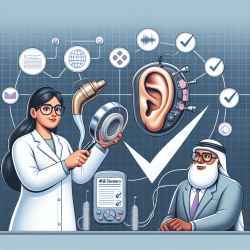In the field of speech-language pathology, ensuring the quality and effectiveness of hearing aids (HAs) is paramount for achieving successful clinical outcomes. A recent study titled "A Critical Appraisal of Nonconformity of New Hearing Aids with American National Standards Institute Standards" sheds light on the compliance rates of HAs with ANSI standards, highlighting significant findings that can inform and improve clinical practices.
The study assessed the compliance of 62 new hearing aids with the ANSI S3.22-2014 standard using the Audioscan Verifit-1 analyzer. The results were concerning, with 96.8% of the HAs failing to meet the equivalent input noise (EIN) measure. However, compliance rates for other parameters such as output sound pressure level (OSPL), high-frequency average (HFA) at 50 dB, and total harmonic distortion (THD) were higher and did not differ significantly across different brands and styles of HAs.
Interestingly, the type of analyzer used had a considerable impact on the EIN compliance rate. While the Verifit-1 showed a low compliance rate of around 5%, the Verifit-2 and Aurical test systems indicated a much higher compliance rate of over 90%. This discrepancy suggests that the limitations of the Verifit-1 analyzer might contribute to the observed noncompliance, rather than the HAs themselves being faulty.
From a clinical perspective, these findings underscore the importance of using accurate and reliable testing protocols. Here are some key takeaways for practitioners:
- Understand the Limitations of Testing Equipment: The study highlights that the choice of analyzer can significantly affect compliance results. Practitioners should be aware of the capabilities and limitations of their testing equipment.
- Adopt Comprehensive Testing Protocols: Given the variability in compliance rates across different analyzers, it is crucial to adopt comprehensive and clinically reproducible testing protocols that ensure accurate measurements.
- Focus on Multiple Parameters: While EIN is an important measure, it should not be the sole criterion for rejecting HAs. Practitioners should consider multiple parameters, including OSPL, HFA, and THD, to make informed decisions.
- Continuous Education and Training: Staying updated with the latest research and advancements in HA technology and testing methods is essential for practitioners to provide the best care for their patients.
By implementing these strategies, practitioners can improve the quality control of hearing aids, leading to better patient outcomes and satisfaction. For a more in-depth understanding of the study and its findings, I encourage you to read the original research paper, "A Critical Appraisal of Nonconformity of New Hearing Aids with American National Standards Institute Standards," available here.










